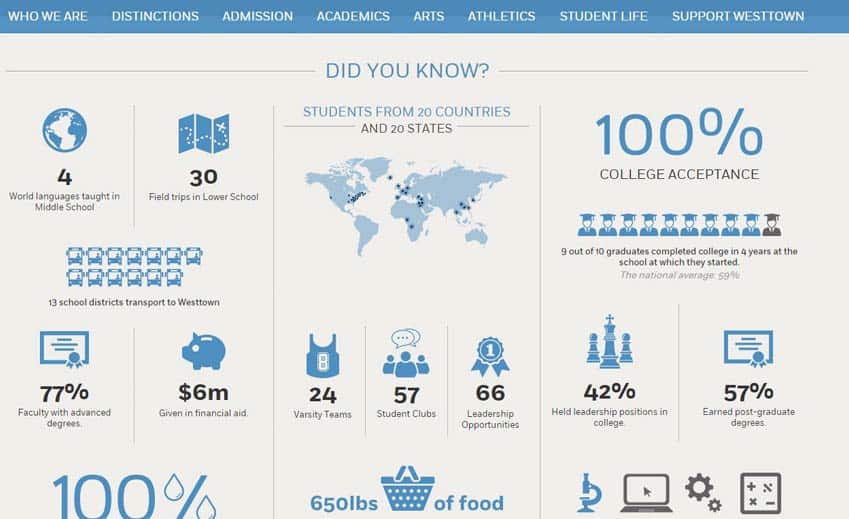
While creating infographics isn’t the most revelatory content marketing idea, it remains one of the most effective. As a way to present information in a visually rich, engaging manner, the format is hard to beat, and has long been a go-to tactic for digital marketing experts across a range of industries.
For schools, infographics can be useful to highlight specific courses, illuminate the future paths of your students, or just present your school’s key messages and values. Keep reading to learn why they should be a part of your overall content marketing strategy.

Why Infographics Resonate with Prospective Students
There are a few simple reasons why infographics tend to resonate with internet users. For a start, it is widely reported that 90 percent of the information the human brain processes is visual, and that humans process images 60,000 times faster than text.
Visual information is also easier to absorb and remember – an MIT study found that images seen for as little as 13 milliseconds can be recalled by the brain.
This makes infographics a great way to break down complex information in a simple, digestible way. By adding illustrative images to your text, readers can register what they are being told more easily.
Example: The University of Manchester created this infographic on industrial biotechnology. Simplifying these kinds of complex topics is one of the most common ways schools use the format.

Infographics can also be a way to add some flair to the ideas you are trying to convey. For example, many infographics like the one above deal with statistics. Regardless of how impressive they are, hard facts and figures can tend to be a little dry for a reader, so pairing them with visuals can help to make them a bit more arresting.
Perhaps even more pertinently for marketers, a University of Minnesota study found that presentations that used visual aids were 43 percent more persuasive than those that didn’t. This means the visual enhancement infographics offer your information could have a big impact on how well it drives engagement.
The Role of Infographics in Digital Content Marketing
In addition to being engaging and informative for your audience, infographics can be a very valuable and versatile education content marketing tool for schools looking to improve their visibility on the web.
Because search engines reward visuals, pages with infographics can rank highly in results, and will also often appear in image searches for targeted keywords.
Schools hoping to attract search traffic from infographics should be careful to include appropriate alt text when posting them on their website, as this allows search engines to index them more easily.
Another way to boost SEO using infographics is to place embed codes within them. This allows other web publishers to post them on their own pages while still giving your site credit, and can help you earn invaluable backlinks to improve your search authority. Infographics are also one the most shareable types of web content available, and can be repurposed across a range of digital channels, including blogs, social media, and email marketing.
What Kind of Infographics can Schools Make?
There are endless potential possibilities for schools looking to create infographics. Educational institutions are naturally great sources for the kind of rich facts and figures that lend themselves well to the format. Things like academic research, statistics about particular fields or subjects, or even just information about your school and its successes can all be excellent starting points.
What you choose will likely depend very much on your institution and the type of content your target personas find engaging. For example, an infographic that outlines the potential career paths your graduates can take could be a simple but effective piece of content that will pay dividends for years to come.
Example: An excerpt from an infographic from the International Beauty Institute which covers potential career paths for makeup artists. A simple topic, but one which will always have relevance to the school’s audience and attract interest.

However, you don’t have to stop there, and many schools will use the format to explore certain specific aspects of the subjects they teach in greater depth, offering them as a visual learning tool to inform both prospective and current students alike.
Example: This clever infographic from Automotive Training Centre provides prospective and current students with a handy breakdown of routine car maintenance tasks.

In addition, some institutions will use infographic content to present facts and figures about their school, often on their homepage or ‘about’ page. This can be an excellent way to make your most pertinent information stand out, and makes a nice alternative to simple list of statistics.
Example: Westtown School uses an infographic on its homepage to present some impressive stats.

Infographics can also be especially valuable if you are dealing with international audiences, since they tend not to use an excessive amount of language, and include visual representations of what they are communicating to aid understanding.
This is just the tip of the iceberg when it comes to what your school could possibly do with the format. If you’re stuck for ideas, a good place to start might be by going through existing blogs or news pieces you have written to see if any of them can be repurposed as an infographic. Not only is this a great way to give your old higher education content marketing material new life, it can cut down on the research and time your team will have to spend on the project.
Tips for Designing Education Content Marketing Infographics
The most important thing to keep in mind when designing infographics is narrative. A good infographic is more than just facts and figures. It will tell a story, presenting the information in a way that makes it flow naturally and easily for its audience.
Above all else, you need to start with a good idea. Carefully consider what you are looking to communicate and how well it will translate to the format. You also should not underestimate just how important the title of your infographic is. An eye-catching title will help it get found and shared across different digital channels.
Once you have an idea in place, the next step is to create a wireframe that illustrates how your infographic will be laid out. How you arrange it will largely depend on what information it needs to contain, but there are a few tried and tested formulas for the format. This handy ‘cheat sheet’ from design template specialists Piktochart breaks down some of the most commonly used layouts:

The company has broken down their wireframes into six basic categories:
Useful Bait: This is a simple all-purpose design that somewhat resembles a print newspaper or magazine layout, and can be used for many different kinds of subjects.
Versus/comparison: This is an arrangement for an infographic that compares two different things. It could be useful for schools looking to present the pros and cons of different courses, career paths, or study options.
Heavy Data: This layout contains a number of different charts and other elements that are useful if you need to present a lot of statistics or other kinds of data.
Road Map: A very common format for infographics, this option can be very useful if you are looking to present a linear process or journey, such as the path to a qualification, or a particular task that students learn to complete.
Timeline: This can be very good for informative infographics that detail the history of a particular subject, or even of your school itself.
Visualized Article: This format leaves more room for text than most infographics, and could be used if your chosen subject doesn’t fit all that easily into an image-heavy design, and needs more illumination.
These kinds of templates will help you to get a sense of how well the information you have fits into the format, and what kind of visuals you need to create.
Another important thing to note is that you should always cite any sources you use, particularly for facts and statistics. Most publishers do this by noting the URLs of their sources at the bottom of their infographics.
Mistakes to Avoid When Creating Infographics for Your School
There are a number of mistakes that many infographic creators make, particularly when they are new to the format. One of the most common is making the design too busy. While you may feel that you have lots of interesting and important information to share in a single infographic, cramming it with images and facts and figures will make it harder to follow for readers, and less visually appealing. Try to include a healthy amount of whitespace in your design.
Another failing of many poorly designed infographics is that they contain too much text and not enough visuals. As a general rule of thumb, you should aim to have some form of visualization for every piece of information you present.
Of course, both of these points arguably come down to the same failing, which is trying to force content that doesn’t fit into an infographic. If your school finds that an idea you have come up with doesn’t lend itself as easily to the format as you thought, it may be worth considering whether it would really be better as a blog, or a presentation, or even a video.
With the right approach, however, infographics can be a tremendous asset in content marketing for education, and your school should have no shortage of ideas for the format once you start looking for them. If they are not currently part of your content calendar, it may be high time you pencilled them in.






